HISTORY OF REVIVALISM OR Pukkumina’
revivalism, generally, renewed religious fervour within a Christian group, church, or community, but primarily a movement in some Protestant churches to revitalize the spiritual ardour of their members and win new adherents. Revivalism in its modern form can be attributed to that shared emphasis in Anabaptism, Puritanism, German Pietism, and Methodism in the 16th, 17th, and 18th centuries on personal religious experience, the priesthood of all believers, and holy living, in protest against established church systems that seemed excessively sacramental, priestly, and worldly. Of central importance, however, was the emphasis on personal conversion.
Among the groups that contributed to the revival tradition, the English Puritans protested against what they saw as the sacramentalism and ritualism of the Church of England in the 17th century, and many migrated to America, where they continued their fervour for experiential religion and devout living. The Puritan fervour waned toward the end of the 17th century, but the Great Awakening (c. 1720–50), America’s first great revival, under the leadership of Jonathan Edwards, George Whitefield, and others, revitalized religion in the North American colonies. The Great Awakening was a part of a larger religious revival that was also influential in Europe. From the late 17th to the mid-18th century, Protestantism in Germany and Scandinavia was revitalized by the movement known as Pietism. In England a revival led by John Wesley and others eventually resulted in the Methodist movement.
Toward the end of the 18th century another revival, known as the Second Great Awakening (c. 1795–1835), began in the United States. During this revival, meetings were held in small towns and the large cities throughout the country, and the unique frontier institution known as the camp meeting began. The Second Great Awakening produced a great increase in church membership, made soul winning the primary function of the ministry, and stimulated several moral and philanthropic reforms, including temperance, emancipation of women, and foreign missions.
After 1835 revivalists traveled through the towns and cities of the United States and Great Britain, organizing annual revival meetings at the invitation of local pastors who wanted to reinvigorate their churches. In 1857–58 a “prayer meeting revival” swept U.S. cities following a financial panic. It indirectly instigated a revival in Northern Ireland and England in 1859–61.
The preaching tour of the American lay evangelist Dwight L. Moody through the British Isles in 1873–75 marked the beginning of a new surge of Anglo-U.S. revivalism. In his subsequent revival activity, Moody perfected efficient techniques that characterized the urban mass evangelistic campaigns of early 20th-century revivalists such as Reuben A. Torrey, Billy Sunday, and others. The interdenominationally supported revivalism of Moody and his imitators in 1875–1915 constituted, in part, a conscious cooperative effort by the Protestant churches to alleviate the plight of urban industrial society by evangelizing the masses and, in part, an unconscious effort to counter the challenge to Protestant orthodoxy brought on by the new critical methods of studying the Bible and by modern scientific ideas concerning evolution.
Revivalism is usually considered to be those movements within Christianity which emphasizes the religious appeal to the emotions as well as to intellect of individuals to restore them to an active participation in Christian activities. It believes that a vital Christianity begins with the response of the individual's whole being to the gospel call for repentance and spiritual rebirth to faith in Jesus Christ. This experience is the beginning of a personal relationship to God. Some have sought to make revivalism just an American experience and only on the frontier in the early years of the American continental expansion. But revivalism can be seen to be a much broader Christian phenomena. The modern revival movement has its historical roots in the Puritan-pietistic reaction to the rationalism of the Enlightenment and to the Lutheran and Calvinistic theological creedal formulations of Reformation faith that characterized much of the seventeenth century. This reaction resisted the depersonalization of their religion. These revivalists emphasized a more experiential element of their Reformation faith which emphasized personal commitment and obedience to Christ and a life regenerated by the indwelling Holy Spirit. They also emphasized personal witness and missions as a primary responsibility of the individual Christian and of the church. Subjective religious experience and the importance of the individual became a new force in the renewing and expansion of the church. These concerns gradually permeated much of Protestantism, especially in the developing churches in America.
I’m really interested in Jamaican religions but trying to summarise an entire belief system down to understand it, especially one that is syncretic isn’t easy. This partly comes from not having a religion of my own. I have to say for a religion that is still alive in Jamaica today there is very little information published online about it. Much of what I read referenced Edward Seaga who studied Revivalism back in the 1950s and 60s so I’m unsure what elements of the religion outlined below remain in contemporary Revivalism.
Pukkumina and Zion are the two main groups of Revivalism which emerged during the ‘Great Revival’ of 1860 in Jamaica. A religious fervour swept across the island, amassing followers to Baptist and Moravian churches. Taking inspiration from Myalism and Kumina, Revivalism was the new style of worship. A religion characterised by dancing and spirit possession took place in churches and ‘Revival yards’. Pukkumina and Zion are very similar in terms of how they are organised and in their method of ritual worship, however it is where each group places their emphasis (either the African or Christian side) that sets them apart.
Pukkumina focuses more on the African belief of ‘earth’ and ‘ground’ spirits (spirits of ancestors and fallen angels). Members are structured into ‘bands’ where each have a role to perform (‘Leaders’, ‘post holders’ and ‘floor members’) in rituals where spirit possession is central to worship. Spirit possession involves ‘travel’ into the spirit world and the summoning of spirits with the aid of cymbals, dance and prayer. Meetings take place in a Pukkumina ground (usually the leader’s yard) marked with a pole flying coloured flags to attract passing spirits. The pole marks the centre of the yard which is the ‘seal’ (a sacred, consecrated area).
Zion Revival focuses more on the Christian belief in one god, of ‘heavenly spirits’ (angels and saints). Led by the ‘mother’/’shepherdess’ if female or a ‘captain’ /’shepherd’ if male, Zion Revivalists are considered more specialised in the art of healing the spirit, receiving ‘messages’ via spirit possession and herbal medicines. All of these practices are derived from Myalism.
border="0" cellpadding="0" cellspacing="0" style="width: 515px;">
The Great Awakening was the name given to the evangelical religious movement which swept America in the 18th and 19th centuries. The first wave began shortly after the arrival of European settlers in the early 1700's and resulted in the growth of the Presbyterian, Methodist, and Baptist Churches. The Second Great Awakening began in the last decade of the 18th century and reached its peak in the second half of the 19th century in the revivalist oratory and hymnody of camp meetings and in gatherings of the Salvation Army, the YMCA, and other Protestant affiliated sects.
| Rendering of a Southern evangelist preaching. |

Revivalist
Poetry & Song
| In these revivalist services music played a significant role. Preachers used the congregational singing of hymns, psalms,
and spirituals as a form of emotional bonding. As more and more of the African-American population became Christians,
black and white music found a common ground in revivalist services, especially in the outdoor camp meetings which
functioned as religious, social, and recreational gatherings. One of the most dynamic evangelist teams was comprised of
Dwight L. Moody, a former Boston shoe salesman, and Ira David Sankey, a musician and singer. Together they took their
message across America, staging revival meetings at which Moody preached and prayed and Sankey sang what came to be
called Gospel songs. Other composers who contributed to revivalist music included William Bradbury, Philip Bliss, and
Robert Lowry. It was Lowry's hymn AT THE RIVER which was to capture the imagination of several subsequent composers,
among them Charles Ives, who incorporated the tune into CHILDREN'S DAY AT
THE CAMP MEETING, and Virgil Thomson, who
used it in his VARIATION ON SUNDAY SCHOOL TUNES.
Revivalism also acquired a political perspective, as fundamentalists sought to influence government to adhere to their conservative moral perspectives. One of the most dramatic clashes resulting from this thinking occurred at the 1925 Scopes Trial in which a Tennessee teacher was accused of instructing his pupils in Darwin's--not the Bible's--view of the creation story. The fiery fundamentalist orator and former Presidential candidate, William Jennings Bryan, transforming courtroom into church, won the conviction that was later overturned on a technicality, though the Tennessee law banning Darwin remained in effect until 1967.
WHAT IS REVIVALIST
| ||||||||||
Pocomania or Pukkumina (possibly from Span., ‘a little madness’). Afro-Jamaican cults descended from surviving forms of African religion mixed with Protestant elements from the time of the Great Revival in Jamaica in 1860–2. They take the form of small local ‘bands’ led by a ‘Captain’, ‘Mother’, or ‘Shepherd/ess’ who lives at and rules over the band's Yard. Pocomania passes over into ancestor-spirit cults on one side, and into Revival Zion on the other, and some adherents belong to the Christian churches.
Revivalism
in Jamaica
In revivalism those possessed with the spirits are generally linked with a personal spirit. In most case, if not all, it is the spirit who selects the individual and becomes personally attached as a personal guardian and adviser to the possessed. The revivalist spiritual world is categorized into three realms: • Heavenly spirits • Earth - bound spirits • Ground spirits
Some Revival Churches and practically all healing centers and balm yards are decorated with high poles with flags, which are used to attract passing spirits. Sometimes, the pole is planted in the “Seal” or mission ground. The seal is the center for most of their important ritual activity and is deemed sacred. It is said that all the spirit of the dead, that work with the revival ‘bands’ actually lives at these spots.
Other than the normal church service and balm yard activities, revivalism is characterized by major ritual forms, which can be classified into two groups: • Street Meeting and Prayer Meeting • Rituals for specific purposes Feasting Tables or Duties etc. Prayer meetings are held for different purposes and usually take the form of bible reading, singing and discussion. Street meetings are held mainly to get new members, to preach biblical doctrine. Rituals for specific purpose are “table” or “duties” held for various purposes such as thanks-giving for a particular events, prosperity, deliverance, memorial, death and judgement, mourning, consecration pole-planting, ordination, dedication, and baptism. In Pocomania the feasting table is usually held on Sunday nights. The table is spread with fruits, drinks, bread, candles and vegetable. After bible reading and greetings of visitors, the table is “broken” at midnight, the food distributed among those present. On the other hand in Zion their feasting table is never held on Sundays. Both groups combine Bible reading, preaching, singing and movement in these rituals, invoking the spirits to enter the ceremony.
• Madda de great stone got to move. • Daniel saw de stone, rolling into Babylon, • My young companion fare the well, • Rock oh! Rock holy, rock oh! Rock holy, • No stone in the de valley, no stone, • For me eye nuh blin, an mi ears no deaf. Revival Churches can be found all over Jamaica, particularly in the deep rural areas and in the inner-city sections of the corporate area. On specific dates, towards the end of each quarter within the year, revivalists may be seen journeying to Watt Town, St. Ann. This is one of the most popular revival meeting places. At Watt Town, all aspects of the religion are usually on display: there is the church service, which entails bible reading, singing of hymns and choruses, trumping and the cymbals, dancing, spiritual possessions, healing and sometimes warning.
The 1860 Revival in Jamaica
The worldwide revival of 1857-8 This worldwide revival won a million souls to Christ in America and a similar number across the British Isles. The universal church was re-vitalised; there was an explosion of lay workers in home churches as well as missionaries commissioned for work overseas. Theological seminaries became crowded with ministry candidates. Veteran revivalists like Charles Finney, James Caughey, Walter and Phoebe Palmer rode on this wave of revival reaping masses of converts. D .L. Moody converted in 1855, caught fire in the revival and soon became the foremost advocate of mass evangelism, his own ministry shaking two continents. Others like R. A. Torrey and J. Wilbur Chapman followed and took on the burden for evangelism. William and Catherine Booth, converted under the ministry of James Caughey, launched the Salvation Army and attracted great crowds to Christ. Charles Haddon Spurgeon preached to capacity crowds each week, filling the largest halls in London. The largest church in the world was on the island of Hawaii with over 5,000 regular attendees and up to 11,000 in meetings. Hudson Taylor began the China Inland Mission. Lord Shaftsbury championed for the cause of the young, the poor and the oppressed. The 17 year old Thomas Barnardo was converted in 1862 and founded his famous orphanages. David Livingstone and Mary Slessor propagated missionary work in Africa. In 1865, William Booth and his wife Catherine opened The Christian Revival Society, (later changed its name The Salvation Army), and offered repentance, salvation and a new life with Christ to the poorest and most needy, including alcoholics, criminals and prostitutes. Pastoral work, evangelistic activity, missionary outreach, social enterprise – the entire Church of Jesus Christ was powerfully and universally renewed. Such was the impact of this great awakening and the church in Jamaica was no exception. Revival comes to Jamaica When news of the 1857-58 Awakening reached Jamaica the faithful saints began to pray for spiritual revival on the island. The ‘noon-day prayer meeting’ model that God had employed elsewhere could not be replicated among a population occupied in plantation work. Nevertheless the church was determined to go before God on its knees. By early 1860 there had developed a confident expectation that God would soon visit the Jamaican church, but no one anticipated the ‘copious showers’ that were soon to fall, for two glorious years. Soon the pattern of earnest prayer, followed by the conviction of sins and painful penitence, and then outright conversions, commenced. What began with small revival prayer meetings became an awakening of the masses. Almost every place of worship was crowded to capacity, for it seemed the whole population wanted to hear the good news of Christ. Backsliders returned. Thousands were converted and baptised. Great numbers sought admission to church membership, including more young people than one missionary had seen in 30 years. Reading of the Bible, praise, prayer, and preaching became the norm during the first phase of revival. There was widespread conviction of sin, crime lessened, ethical standards were raised, old superstitions lost their power, broken marriages were healed, many left their lovers and returned to their families, and thousands of co-habiting couples were united in Christian marriage. Drunkards became abstainers, former blasphemers invoked the name of God with respect and holy fear, rum shops and gambling houses were closed and prodigal children were reclaimed. The moral landscape of the nation was dramatically transformed during these months of the revival. Revival beginnings It was during September 1860, that this unprecedented evangelical awakening began among the Moravians in St. Elizabeth Parish, in the southwest. It soon spread like wild fire, first to the three parishes of St. James, Hanover, and Westmoreland, causing a sensation in local congregations, regardless of denomination. Eastwards the movement quickened Mandeville and spread along the coast to villages and hamlets, eventually affecting the entire island - from Montego Bay to St. Thomas, from St. Ann’s Bay to Savanna-la-Mar. The most notable feature of this awakening was prayer. People whose lips seemed solely accustomed to curse and to swear now prayed as fluently as if such petition had been the daily employment of their lives. The prayer meetings seemed to generate a supernatural force which carried the multitudes along on a wave of irresistible power which, in turn, produced passionate repentance, astonishing moral reformation and fervent longing to know and love and serve the Lord Jesus Christ.. There is one very exciting private journal of the period, penned by a Moravian missionary, the Rev. Theodor Sonderman, which gives us a glimpse into the beginnings of the revival movement. When he visited Clifton he was told that a strange meeting was going on, so he rode on until he met a crowd of people, some weeping for joy, others under deep conviction, and others bewildered by the events. He tried to allay excitement, but while himself engaged in prayer, his own feelings overpowered him, so he felt it wise ‘to leave them to the direction of the Holy Spirit.’ On Friday, September 28th, a typical meeting there commenced at nine o’clock. One verse of a hymn was sung and an opening prayer was offered. (Diary, 28th Sept., 1860) There was no need to call on anyone to pray for no sooner had one finished than another began. Even the little children took part in the intercession. When one little boy began to pour out his soul before the Lord, trembling seized upon the company. Tears were shed and cries for mercy heard, while groans were torn from the hearts of hardened sinners. One little girl lifted up her voice in prayer in earnestness, fervency, and fluency. And then the Spirit came ‘like a rushing mighty wind,’ to quote the German missionary. Strong men trembled upon their knees as though shaken by some invisible power. Weeping was so general and so incessant the missionary feared it would get out of order. The meeting ended at twelve, but many reassembled at the school house to continue while the missionary talked to those distressed. One day later, Sonderman reflected, he might as well have attempted to stop the river in its course as to stem the streams of the outpouring of hearts, yet on that day quiet order and utter decorum prevailed in the church. The revival spreads In a prayer meeting held in one notoriously wicked place, two younger women were struck down as though by lightning, whereupon one confessed her life of sin. Then two younger men were struck dumb, one of them writhing in agony. (Diary, 4th Oct., 1860) The work in St. Elizabeth had awakened very many from their sleep of religious formality, and also prostrated many ungodly persons. In four weeks, the Moravian pastor had conversed with 315 inquirers. In early November another minister travelled to Montego Bay to preach a Sunday sermon. To his great surprise, from five o’clock on Saturday evening onwards, there came a stream of inquirers. God was visiting the town and a God-consciousness seemed to settle upon the people. God was the topic of conversation everywhere - in the market-place and shops, amongst merchant planters and field-hands alike. The whole town was in a state of excitement, although as in usual in during authentic revivals, some were mocking and some praising God. (Letter, 20th Nov., 1860) After delivering his messages in Bethel Town, the missionary proposed a prayer gathering at dawn to be held on Monday morning. Five hundred people attended. Another meeting was then announced for Monday evening, presided over by a local preacher. At the conclusion of the service, and just as the final petition was presented, “the Spirit was poured out, and the mighty revival movement had commenced in real earnest,” it was said. The people would not leave the chapel. The missionary was notified and he hastened back on Wednesday evening to witness unforgettable scenes, with as many as one hundred hardened sinners prostrated at once. A dozen couples “living in sin” published “the banns” for legal marriage in a Christian ceremony. At Mount Carey chapel a crowd of twelve hundred people gathered by 11 a.m. the gathering of with many standing outside. A sensation was caused when about seven hearers were prostrated, much to the alarm of the local leadership. In these three places, 3,000 sinners were spiritually “awakened.” They were typical of scenes throughout the island. Great crowds were awe-struck. The few scoffers were besieged by the prayers of their friends until they saw the light of the Gospel. Conversions of the most depraved characters was followed by their untiring ministry on behalf of others. New converts by hundreds went from house to house all day and often at night, entreating sinners to repent. Private homes became holy meeting places for public prayer and Bible reading, with fifty or a hundred crammed together in each place. Sales of Scriptures from the Kingston depot had averaged 4,700 a year but 20,700 copies were issued during the extraordinary awakening of the years 1860 and 1861. Convicted sinners were sometimes smitten “deaf and dumb” or gnashed their teeth, or screamed, or tore their clothes. Some were unconscious for a day or more, others speechless for a week or so. It was not “the fear of hell, but a sense of sin” which brought about distress, they said. Often people told of seeing special visions. “Unaccountable” prostrations were sometimes followed by terrific bodily contortions or by jumping, by shouting, and by wild actions. Numerical results of the revival The Baptists announced more than 6,000 baptized or restored to membership with another 6,000 applying for baptism and fellowship. So great was the Congregationalist growth that the London Missionary Society, by 1867 considered the field sufficiently evangelized, that it withdrew its missionaries completely. The United Presbyterian Church of Scotland announced “the most remarkable and encouraging (news) that have ever come from Jamaica.” Their church membership grew by almost 25% and by the close of 1860 there were 1,928 candidates awaiting admission to membership, and one year later another 1,703. The Wesleyan Methodist Circuit at Montego Bay experienced an exceptional reviving, marked by “strong crying with tears,” with sinners wailing aloud for mercy and many of these people prostrated by conviction. Some 800 in regular membership welcomed 547 professed converts. There were vigorous movements in Lucea and Brown’s Town circuit. Around St. Ann’s Bay Wesleyan congregation had 150 on trial in a regular membership of 500 or so. This was typical of the north coast circuits. On the south coast, Clarendon circuit churches were crowded to excess, with 400 on trial and a membership of 800. Daily meetings for prayer were conducted also in Spanish Town, with 120 converts “on trial,” the regular membership being 650. Several people were prostrated for days on end. By early 1862 Methodists in Kingston had added 708 to membership, with another eighty-two still “on trial;” Montego Bay (807) had added 708, with 220 “on trial;” Spanish Town (655) had admitted 210 with 126 “on trial.’
The 1860 Revival in Jamaica
A phenomenal revival occurred in Jamaica in 1860, which was initially ignited by the great prayer-initiated revival of 1857-58, which began in the United States and went on to affect a great portion of the Western World. The worldwide revival of 1857-8 This worldwide revival won a million souls to Christ in America and a similar number across the British Isles. The universal church was re-vitalised; there was an explosion of lay workers in home churches as well as missionaries commissioned for work overseas. Theological seminaries became crowded with ministry candidates. Veteran revivalists like Charles Finney, James Caughey, Walter and Phoebe Palmer rode on this wave of revival reaping masses of converts. D .L. Moody converted in 1855, caught fire in the revival and soon became the foremost advocate of mass evangelism, his own ministry shaking two continents. Others like R. A. Torrey and J. Wilbur Chapman followed and took on the burden for evangelism. William and Catherine Booth, converted under the ministry of James Caughey, launched the Salvation Army and attracted great crowds to Christ. Charles Haddon Spurgeon preached to capacity crowds each week, filling the largest halls in London. The largest church in the world was on the island of Hawaii with over 5,000 regular attendees and up to 11,000 in meetings. Hudson Taylor began the China Inland Mission. Lord Shaftsbury championed for the cause of the young, the poor and the oppressed. The 17 year old Thomas Barnardo was converted in 1862 and founded his famous orphanages. David Livingstone and Mary Slessor propagated missionary work in Africa. In 1865, William Booth and his wife Catherine opened The Christian Revival Society, (later changed its name The Salvation Army), and offered repentance, salvation and a new life with Christ to the poorest and most needy, including alcoholics, criminals and prostitutes. Pastoral work, evangelistic activity, missionary outreach, social enterprise – the entire Church of Jesus Christ was powerfully and universally renewed. Such was the impact of this great awakening and the church in Jamaica was no exception. Revival comes to Jamaica When news of the 1857-58 Awakening reached Jamaica the faithful saints began to pray for spiritual revival on the island. The ‘noon-day prayer meeting’ model that God had employed elsewhere could not be replicated among a population occupied in plantation work. Nevertheless the church was determined to go before God on its knees. By early 1860 there had developed a confident expectation that God would soon visit the Jamaican church, but no one anticipated the ‘copious showers’ that were soon to fall, for two glorious years. Soon the pattern of earnest prayer, followed by the conviction of sins and painful penitence, and then outright conversions, commenced. What began with small revival prayer meetings became an awakening of the masses. Almost every place of worship was crowded to capacity, for it seemed the whole population wanted to hear the good news of Christ. Backsliders returned. Thousands were converted and baptised. Great numbers sought admission to church membership, including more young people than one missionary had seen in 30 years. Reading of the Bible, praise, prayer, and preaching became the norm during the first phase of revival. There was widespread conviction of sin, crime lessened, ethical standards were raised, old superstitions lost their power, broken marriages were healed, many left their lovers and returned to their families, and thousands of co-habiting couples were united in Christian marriage. Drunkards became abstainers, former blasphemers invoked the name of God with respect and holy fear, rum shops and gambling houses were closed and prodigal children were reclaimed. The moral landscape of the nation was dramatically transformed during these months of the revival. Revival beginnings It was during September 1860, that this unprecedented evangelical awakening began among the Moravians in St. Elizabeth Parish, in the southwest. It soon spread like wild fire, first to the three parishes of St. James, Hanover, and Westmoreland, causing a sensation in local congregations, regardless of denomination. Eastwards the movement quickened Mandeville and spread along the coast to villages and hamlets, eventually affecting the entire island - from Montego Bay to St. Thomas, from St. Ann’s Bay to Savanna-la-Mar. The most notable feature of this awakening was prayer. People whose lips seemed solely accustomed to curse and to swear now prayed as fluently as if such petition had been the daily employment of their lives. The prayer meetings seemed to generate a supernatural force which carried the multitudes along on a wave of irresistible power which, in turn, produced passionate repentance, astonishing moral reformation and fervent longing to know and love and serve the Lord Jesus Christ.. There is one very exciting private journal of the period, penned by a Moravian missionary, the Rev. Theodor Sonderman, which gives us a glimpse into the beginnings of the revival movement. When he visited Clifton he was told that a strange meeting was going on, so he rode on until he met a crowd of people, some weeping for joy, others under deep conviction, and others bewildered by the events. He tried to allay excitement, but while himself engaged in prayer, his own feelings overpowered him, so he felt it wise ‘to leave them to the direction of the Holy Spirit.’ On Friday, September 28th, a typical meeting there commenced at nine o’clock. One verse of a hymn was sung and an opening prayer was offered. (Diary, 28th Sept., 1860) There was no need to call on anyone to pray for no sooner had one finished than another began. Even the little children took part in the intercession. When one little boy began to pour out his soul before the Lord, trembling seized upon the company. Tears were shed and cries for mercy heard, while groans were torn from the hearts of hardened sinners. One little girl lifted up her voice in prayer in earnestness, fervency, and fluency. And then the Spirit came ‘like a rushing mighty wind,’ to quote the German missionary. Strong men trembled upon their knees as though shaken by some invisible power. Weeping was so general and so incessant the missionary feared it would get out of order. The meeting ended at twelve, but many reassembled at the school house to continue while the missionary talked to those distressed. One day later, Sonderman reflected, he might as well have attempted to stop the river in its course as to stem the streams of the outpouring of hearts, yet on that day quiet order and utter decorum prevailed in the church. The revival spreads In a prayer meeting held in one notoriously wicked place, two younger women were struck down as though by lightning, whereupon one confessed her life of sin. Then two younger men were struck dumb, one of them writhing in agony. (Diary, 4th Oct., 1860) The work in St. Elizabeth had awakened very many from their sleep of religious formality, and also prostrated many ungodly persons. In four weeks, the Moravian pastor had conversed with 315 inquirers. In early November another minister travelled to Montego Bay to preach a Sunday sermon. To his great surprise, from five o’clock on Saturday evening onwards, there came a stream of inquirers. God was visiting the town and a God-consciousness seemed to settle upon the people. God was the topic of conversation everywhere - in the market-place and shops, amongst merchant planters and field-hands alike. The whole town was in a state of excitement, although as in usual in during authentic revivals, some were mocking and some praising God. (Letter, 20th Nov., 1860) After delivering his messages in Bethel Town, the missionary proposed a prayer gathering at dawn to be held on Monday morning. Five hundred people attended. Another meeting was then announced for Monday evening, presided over by a local preacher. At the conclusion of the service, and just as the final petition was presented, “the Spirit was poured out, and the mighty revival movement had commenced in real earnest,” it was said. The people would not leave the chapel. The missionary was notified and he hastened back on Wednesday evening to witness unforgettable scenes, with as many as one hundred hardened sinners prostrated at once. A dozen couples “living in sin” published “the banns” for legal marriage in a Christian ceremony. At Mount Carey chapel a crowd of twelve hundred people gathered by 11 a.m. the gathering of with many standing outside. A sensation was caused when about seven hearers were prostrated, much to the alarm of the local leadership. In these three places, 3,000 sinners were spiritually “awakened.” They were typical of scenes throughout the island. Great crowds were awe-struck. The few scoffers were besieged by the prayers of their friends until they saw the light of the Gospel. Conversions of the most depraved characters was followed by their untiring ministry on behalf of others. New converts by hundreds went from house to house all day and often at night, entreating sinners to repent. Private homes became holy meeting places for public prayer and Bible reading, with fifty or a hundred crammed together in each place. Sales of Scriptures from the Kingston depot had averaged 4,700 a year but 20,700 copies were issued during the extraordinary awakening of the years 1860 and 1861. Convicted sinners were sometimes smitten “deaf and dumb” or gnashed their teeth, or screamed, or tore their clothes. Some were unconscious for a day or more, others speechless for a week or so. It was not “the fear of hell, but a sense of sin” which brought about distress, they said. Often people told of seeing special visions. “Unaccountable” prostrations were sometimes followed by terrific bodily contortions or by jumping, by shouting, and by wild actions. Numerical results of the revival The Baptists announced more than 6,000 baptized or restored to membership with another 6,000 applying for baptism and fellowship. So great was the Congregationalist growth that the London Missionary Society, by 1867 considered the field sufficiently evangelized, that it withdrew its missionaries completely. The United Presbyterian Church of Scotland announced “the most remarkable and encouraging (news) that have ever come from Jamaica.” Their church membership grew by almost 25% and by the close of 1860 there were 1,928 candidates awaiting admission to membership, and one year later another 1,703. The Wesleyan Methodist Circuit at Montego Bay experienced an exceptional reviving, marked by “strong crying with tears,” with sinners wailing aloud for mercy and many of these people prostrated by conviction. Some 800 in regular membership welcomed 547 professed converts. There were vigorous movements in Lucea and Brown’s Town circuit. Around St. Ann’s Bay Wesleyan congregation had 150 on trial in a regular membership of 500 or so. This was typical of the north coast circuits. On the south coast, Clarendon circuit churches were crowded to excess, with 400 on trial and a membership of 800. Daily meetings for prayer were conducted also in Spanish Town, with 120 converts “on trial,” the regular membership being 650. Several people were prostrated for days on end. By early 1862 Methodists in Kingston had added 708 to membership, with another eighty-two still “on trial;” Montego Bay (807) had added 708, with 220 “on trial;” Spanish Town (655) had admitted 210 with 126 “on trial.’
When revival came to Jamaica
 A PHENOMENAL REVIVAL occurred in Jamaica in 1860, ignited by the great North American prayer-revival of 1857-58, which affected a great portion of the Western World. A PHENOMENAL REVIVAL occurred in Jamaica in 1860, ignited by the great North American prayer-revival of 1857-58, which affected a great portion of the Western World.The most notable feature of this awakening was prayer. People whose lips seemed solely accustomed to curse and to swear now prayed as fluently as if such petition had been the daily employment of their lives. The prayer meetings seemed to generate a supernatural force which carried the multitudes along on a wave of irresistible power which, in turn, produced passionate repentance, astonishing moral reformation and fervent longing to know and love and serve the Lord Jesus Christ.
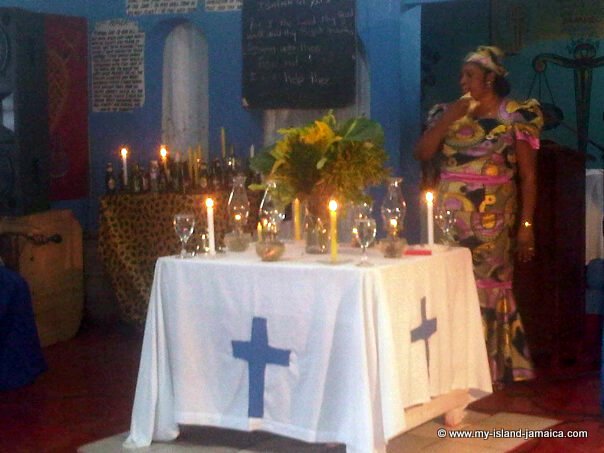 There were two revival churches in my district. They had their
official names but we referred to them as 'Mass Standford church' and
'Madda church' respectively, both representative of the name of the
respective leader in the church.
There were two revival churches in my district. They had their
official names but we referred to them as 'Mass Standford church' and
'Madda church' respectively, both representative of the name of the
respective leader in the church.'Mass Stanford' was closest to my home and we relish the weekends to go there. There was always some activity around the church. Neither me (a boy then) nor any of my family members were members of that faith but as children we loved the experience - although sometimes chilling! I loved the drums. There were two of them- the big bass drum and the 'little drum' (kettle drum). I admired 'Zekel'(Eziekiel), a son of the leader, who played the 'little drum' with dexterity and awe! He was funny, many times played the drums in reggae beats when church is not in session to entertain us (the kids)- Of course, he could not let any of the older members realize that! The religious service are characterized by bible reading, the beating of African drums and cymbals (although more modern instruments are been used today), dancing, spirit possession, and the singing of hymns and choruses. The movements were quite entertaining. The spinning, rotating and whirling are appealing. The entire service is magnetic though-after a while you are virtually pulled into it. 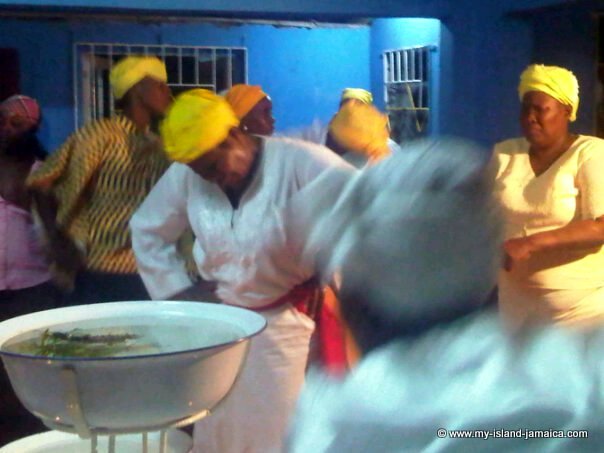 After all, the belief is highly spiritual and mystic! Persons who are 'filled' often roll
on the floor and many times appears to fall in a trance.
After all, the belief is highly spiritual and mystic! Persons who are 'filled' often roll
on the floor and many times appears to fall in a trance. A key aspect of the faith is the warnings and predictions. My first experience at such a service was bloodcurdling! Towards the end of each quarter in the year, revivalists journey to Watt Town in St. Ann (Ocho Rios area of Jamaica). This is the conference center or headquarters (if you wish) of the movement. There, all the elements of revivalism in Jamaica are displayed! I noticed then (and now) though that it is mainly the older folks who are usually involved in the revival church. Could this mean that revivalism in JA may be dying? Honestly, I can't say yeah or nay as I am not as close to the action as I was- when living back in my old district. I can say though that most of the churches are still concentrated in deep rural areas and those are quite steamy. For a great background into the history of revivalism in Jamaica, including the activities involved, a few more pictures and even some of their songs, take a look here then come back. Thanks to brother Carl and my friend Holly Allen, here are some additional pictures from a revivalist service in Jamaica. 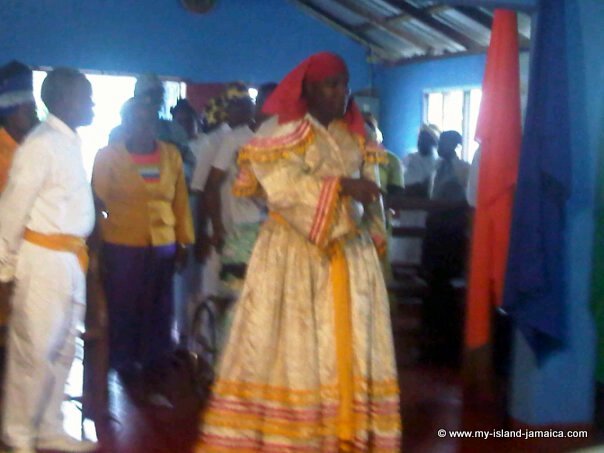
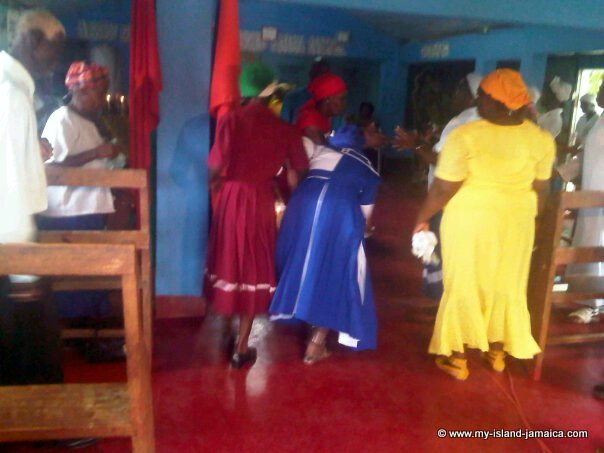
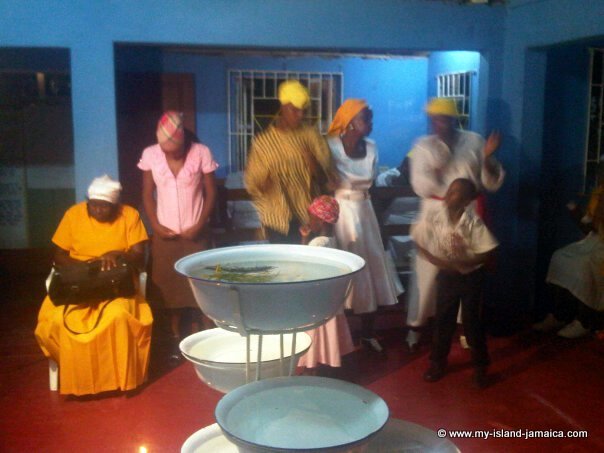
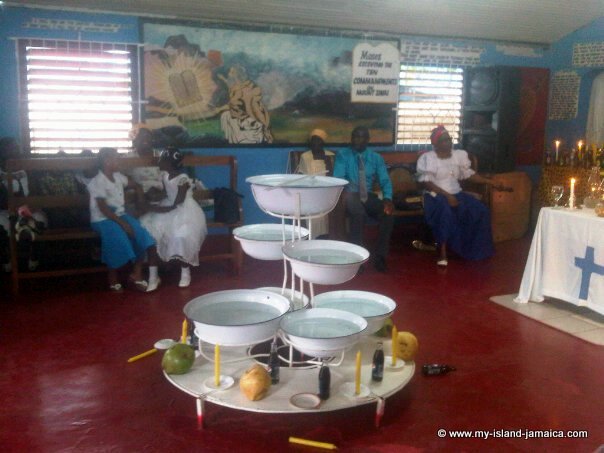
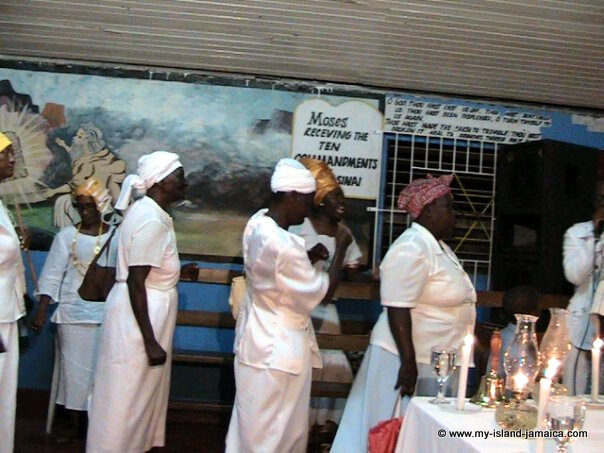
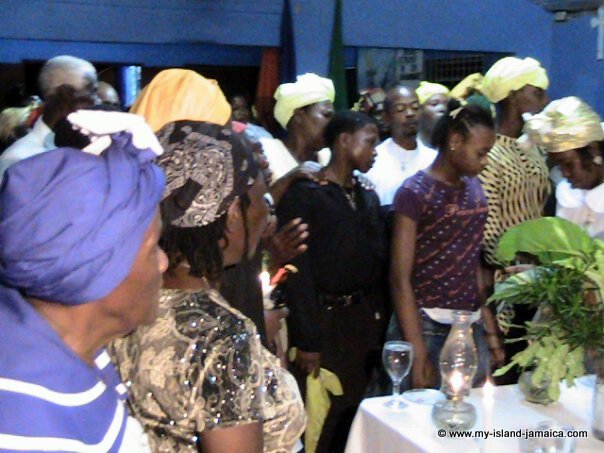
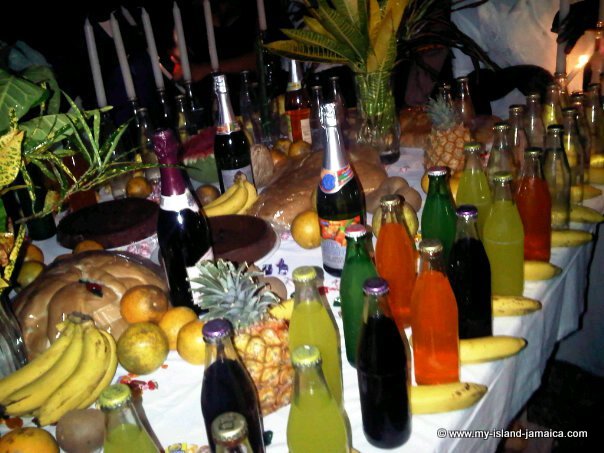 |




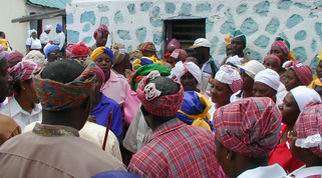
am doing some reading revivalism can someone tell me what is the meaning of crotney flowers in church
ReplyDelete